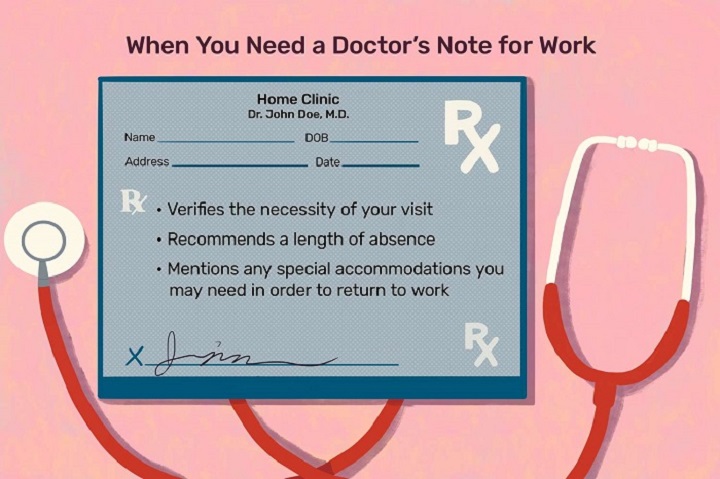In today’s fast-paced world, balancing work responsibilities with personal health can be challenging. Illnesses, medical appointments, or unexpected emergencies may require time off from work. In such situations, a doctor’s note can be a crucial document to bridge the communication gap between an employee and their employer. But what exactly is a doctor’s note, and how does it work? This comprehensive guide aims to answer all your questions about doctor’s notes for work, including their purpose, legality, types, and how to obtain one.
Understanding Doctor’s Notes

What is a Doctor’s Note:
- A doctor’s note, also known as a medical certificate or physician’s statement, is a document issued by a healthcare professional that verifies an individual’s medical condition and their inability to work for a specific period.
- It serves as official documentation of an employee’s health status and outlines any restrictions or accommodations necessary for their return to work.
Purposes of Doctor’s Notes:
- Verification of Illness: Doctor’s notes provide employers with evidence that an employee’s absence from work is due to a legitimate medical condition.
- Legal Compliance: In many jurisdictions, employers are required by law to accept doctor’s notes as proof of illness for granting sick leave and other related benefits.
- Communication Tool: Doctor’s notes facilitate clear communication between employees, employers, and healthcare providers regarding the employee’s health status and any necessary accommodations.
- Preventing Abuse: Requiring doctor’s notes helps deter employees from taking unauthorized sick leave, reducing absenteeism and promoting workplace accountability.
Legal Aspects of Doctor’s Notes
Employer Obligations:
- Laws regarding the acceptance of doctor’s notes vary by jurisdiction, but in general, employers are legally obligated to recognize and respect valid medical documentation provided by employees.
- Failure to comply with legal requirements regarding sick leave and doctor’s notes can result in legal consequences for employers, including fines and potential lawsuits for discrimination or wrongful termination.
Employee Rights:
- Employees have the right to privacy regarding their medical information, and employers are typically prohibited from requesting unnecessary or overly detailed medical documentation.
- However, employees may be required to provide a doctor’s note if their absence exceeds a certain duration or if there are concerns about the legitimacy of their illness.
Types of Doctor’s Notes

Traditional Doctor’s Notes:
- Written on official letterhead and signed by a licensed healthcare professional, traditional doctor’s notes provide a brief summary of the patient’s medical condition and the recommended duration of leave.
- They may include information such as the date of examination, diagnosis, treatment plan, and any restrictions on work activities.
Electronic Doctor’s Notes:
- With the advancement of technology, many healthcare providers now offer electronic doctor’s notes, which can be transmitted directly to the employer via email or secure online portals.
- Electronic doctor’s notes offer the same level of legitimacy and detail as traditional paper notes but provide added convenience and efficiency for both employees and employers.
Telemedicine Doctor’s Notes:
- Telemedicine services allow patients to consult with healthcare providers remotely via phone or video conferencing.
- Telemedicine doctor’s notes are becoming increasingly common and can be just as valid as traditional in-person notes, providing employees with quick access to medical documentation without the need for an office visit.
How to Obtain a Doctor’s Note
Schedule an Appointment:
- To obtain a doctor’s note, an employee should schedule an appointment with their healthcare provider as soon as possible after falling ill or experiencing a medical issue.
- Many doctors’ offices offer same-day or next-day appointments for urgent medical concerns, and some may even provide telemedicine consultations for added convenience.
Provide Relevant Information:
- During the appointment, the employee should provide their healthcare provider with relevant information about their symptoms, medical history, and any medications they are currently taking.
- Clear communication is essential to ensure that the doctor’s note accurately reflects the nature and severity of the employee’s condition.
Request a Doctor’s Note:
- If the healthcare provider determines that the employee is unable to work due to illness or injury, the employee can request a doctor’s note to provide to their employer.
- The doctor’s note should include the necessary details outlined earlier, such as the date of examination, diagnosis, treatment plan, and recommended duration of leave.
Tips for Employees
- Be Honest: It’s important for employees to be honest with their healthcare providers about their symptoms and limitations to ensure they receive appropriate medical care and documentation.
- Keep Records: Employees should keep copies of any doctor’s notes, medical bills, or other relevant documentation for their records, as these may be needed for insurance claims or legal purposes.
- Communicate with Employer: Employees should communicate openly and honestly with their employer about their health status and any expected absences from work, providing timely updates as necessary.
A Doctor’s notes play a vital role in the employer-employee relationship, providing a transparent and legally compliant means of documenting and verifying employee absences due to illness or injury. By understanding the purpose, legality, types, and process of obtaining doctor’s notes, both employers and employees can navigate workplace absences with clarity and Adoctor’s note is not just a piece of paper; it’s a crucial tool that ensures transparency, accountability, and compliance with legal requirements in managing employee health-related absences from work.


